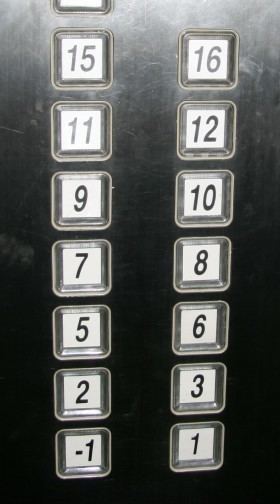 | ||
The thirteenth floor is a designation of a level of a multi-level building that is often omitted in countries where the number 13 is considered unlucky. Omitting the 13th floor may take a variety of forms; the most common include denoting what would otherwise be considered the thirteenth floor as level 14, giving the thirteenth floor an alternate designation such as "12A" or "M" (the thirteenth letter of the Latin alphabet), or closing the 13th floor to public occupancy or access (e.g., by designating it as a mechanical floor).
Contents
- Origin
- Skipped
- 12A 12B 14A and 14B
- Special designations
- Uninhabited 13th floor
- Letter M
- Split level apartments
- Variant
- Thirteenth room
- Highway 13
- Conspiracy theory
- References
Reasons for omitting a thirteenth floor include triskaidekaphobia on the part of the building's owner or builder, or a desire by the building owner or landlord to prevent problems that may arise with superstitious tenants, occupants, or customers. In 2002, based on an internal review of records, Dilip Rangnekar of Otis Elevators estimated that 85% of the buildings with Otis brand elevators did not have a floor named the 13th floor. Early tall-building designers, fearing a fire on the 13th floor, or fearing tenants' superstitions about the rumor, decided to omit having a 13th floor listed on their elevator numbering. This practice became commonplace, and eventually found its way into American mainstream culture and building design.
Origin
The origin of skipping the thirteenth floor when installing elevators is not known. However, during the advent of early skyscrapers, New York architectural critics warned developers not to exceed the height of the 13th floor. These critics insisted that buildings rising above the 13th floor (130 feet or 40 metres) would lead to increased street congestion, ominous shadows and lower property values. Nevertheless, in a work published in 1939, sociologist Otto Neurath compared the use of money in an economy, which he saw as unnecessary, to the superstition of not installing the thirteenth floor: merely a social convention.
Skipped
Most commonly, 13 is skipped, as in: 12, 14, 15... The floor labeled "14" on the elevator is the thirteenth floor and the number 13 is skipped on the elevator console.
12A, 12B, 14A, and 14B
Sometimes the 13th floor is simply renumbered as 12A or 12B, as in: 12, 12A, 14.., or 12, 12B, 14; this does not affect the numbers of the higher floors. Likewise, 14A or 14B could be used for the 13th floor.
Special designations
Other buildings will often use names for certain floors to avoid giving a floor on the building the number 13 designation. One such example is the Radisson Hotel in Winnipeg, Manitoba, where the 13th floor is called the Pool floor. Another example is the Sheraton on the Falls in Niagara Falls, Ontario, where the 13th floor consists solely of a restaurant. A third example is the Trump International Hotel and Tower Chicago in Chicago, Illinois, where the 13th floor is the Mezzanine floor.
Uninhabited 13th floor
Sometimes, the floor is put to some other use, such as a mechanical floor. Such usage is sometimes the subject of conspiracy theories (see below).
Letter M
Because the letter M is the 13th letter in the Latin alphabet, some people may use a letter M as a substitute for the floor numbered 13, such as 12, M, 14, and so forth. In Richmond, Virginia, the Monroe Park Towers has a 13th floor, but it is used for mechanical equipment and is only accessible from the freight elevator or the stairs. The M designation on the elevator buttons of the freight elevator can also be construed as meaning the Mechanical level in this particular building, or as a Mezzanine level.
Split-level apartments
Sometimes, a tenement block will contain split-level apartments where the units themselves contain internal staircases and the main elevators for the building therefore do not stop on every floor. One example is Princess Towers in Kingston, Ontario, which has 16 1⁄2 stories excluding the roof-top. The elevators stop at B (basement), G (ground), 3, 6, 9, 12 and 15th floors only. In this case, the unmarked 11th and 13th floors are accessed within units on the marked 12th floor.
Variant
Similarly, new buildings in some parts of China avoid the fourth, fourteenth, twenty-fourth, etc. floors, as the word "four" (Hanzi: 四) sounds like "death" (死 – pronounced "sì" and "sǐ", respectively) in Mandarin, the predominant language for the country, and most other varieties of Chinese. A small number of buildings also follow the American tradition of omitting the thirteenth floor, with the fifteenth floor immediately following the twelfth.
In South Korea, buildings tend to include the fourth floor in spite of similar pronunciation issues in the Korean language, though some newer buildings may substitute the letter F in the place of the number 4.
Thirteenth room
In some buildings, 13 is also skipped as a room number. The 13-room (as of 1946) Boots Court Motel on U.S. Route 66 is one example; its rooms are numbered 1, 2, 3, 4, 5, 6, 7, 8, 9, 10, 11, 12 and 14.
Highway 13
While many jurisdictions do use Highway 13 as a valid number, in the province of Ontario, Canada, the number has never been issued and is skipped.
Likewise, a U.S. Route 666 in the United States Numbered Routes system, known as the Devil's Highway, was renumbered to U.S. Route 491 in 2003 (however, this happened only after its parent, the famous U.S. Route 66, was decommissioned in 1985).
Conspiracy theory
Some conspiracy theorists have suggested that the thirteenth floor in government buildings is not really missing, but actually contains top-secret governmental departments, or more generally that it is proof of something sinister or clandestine going on. This implication is often carried over, implicitly or explicitly, into popular culture; for example in:
